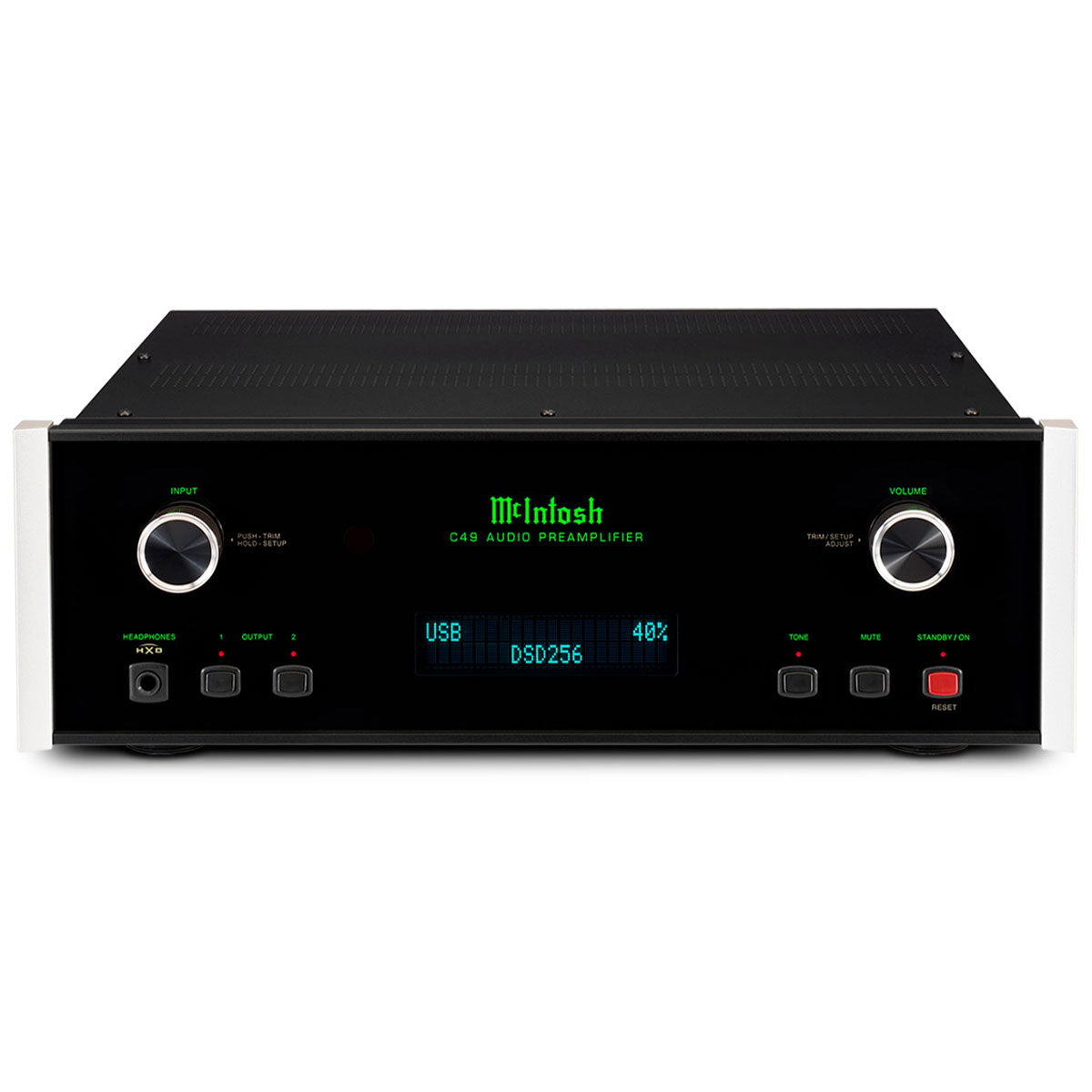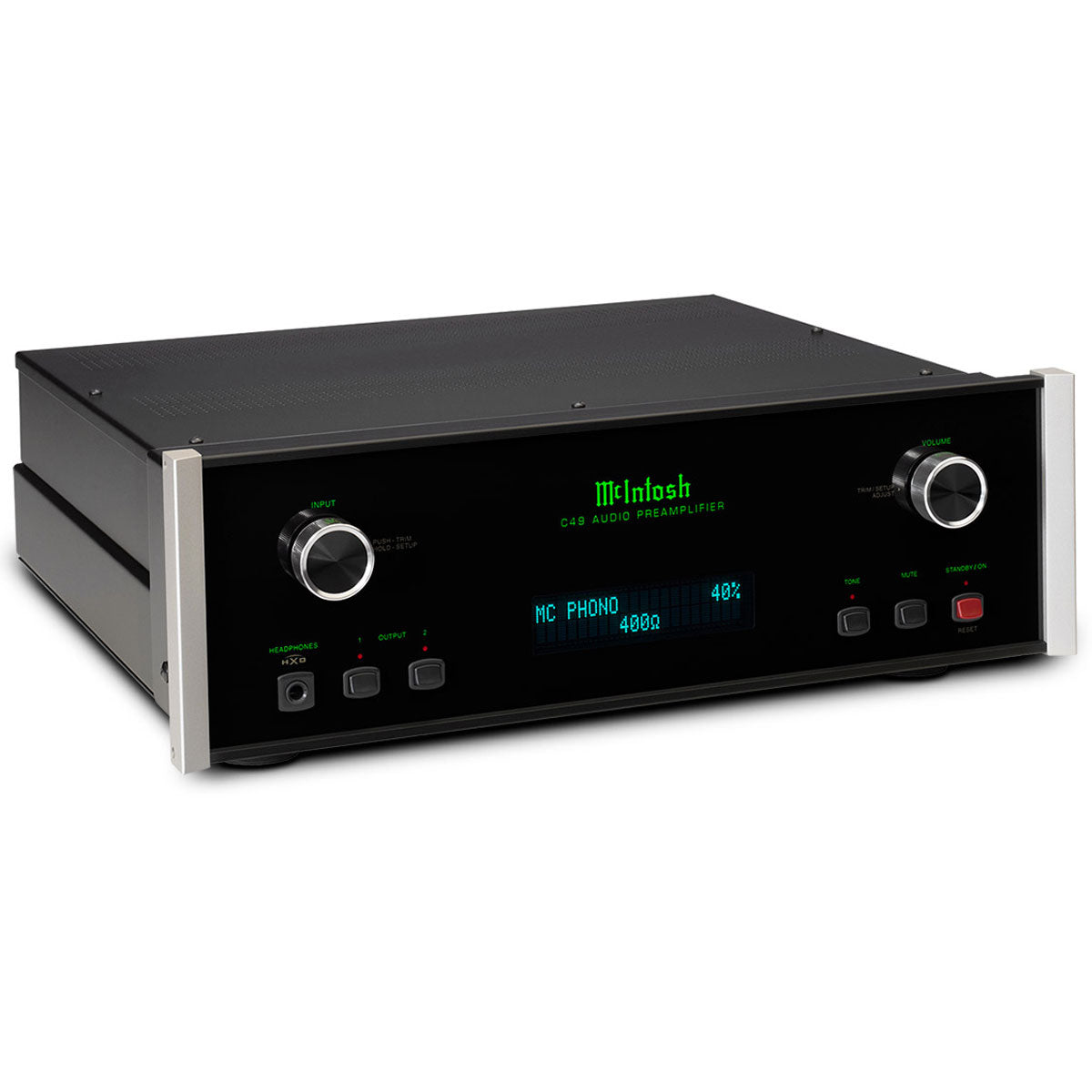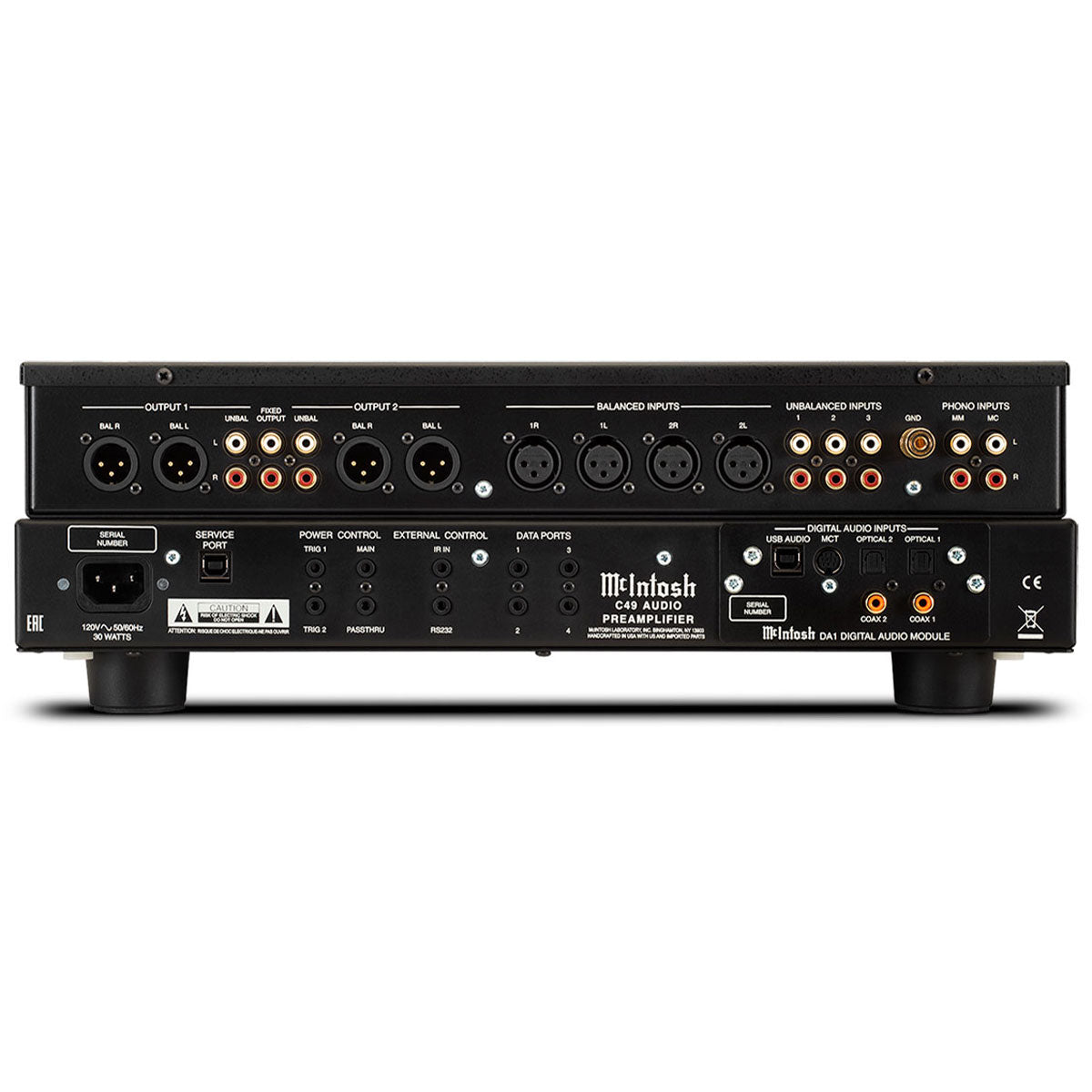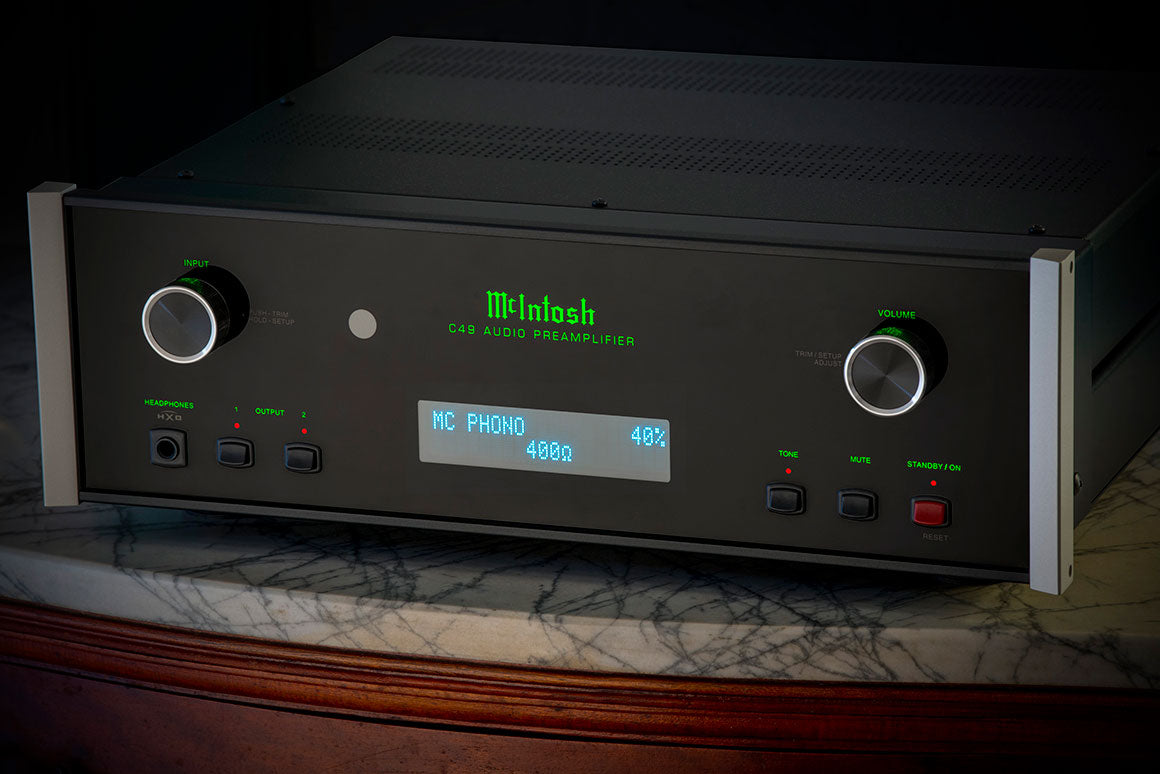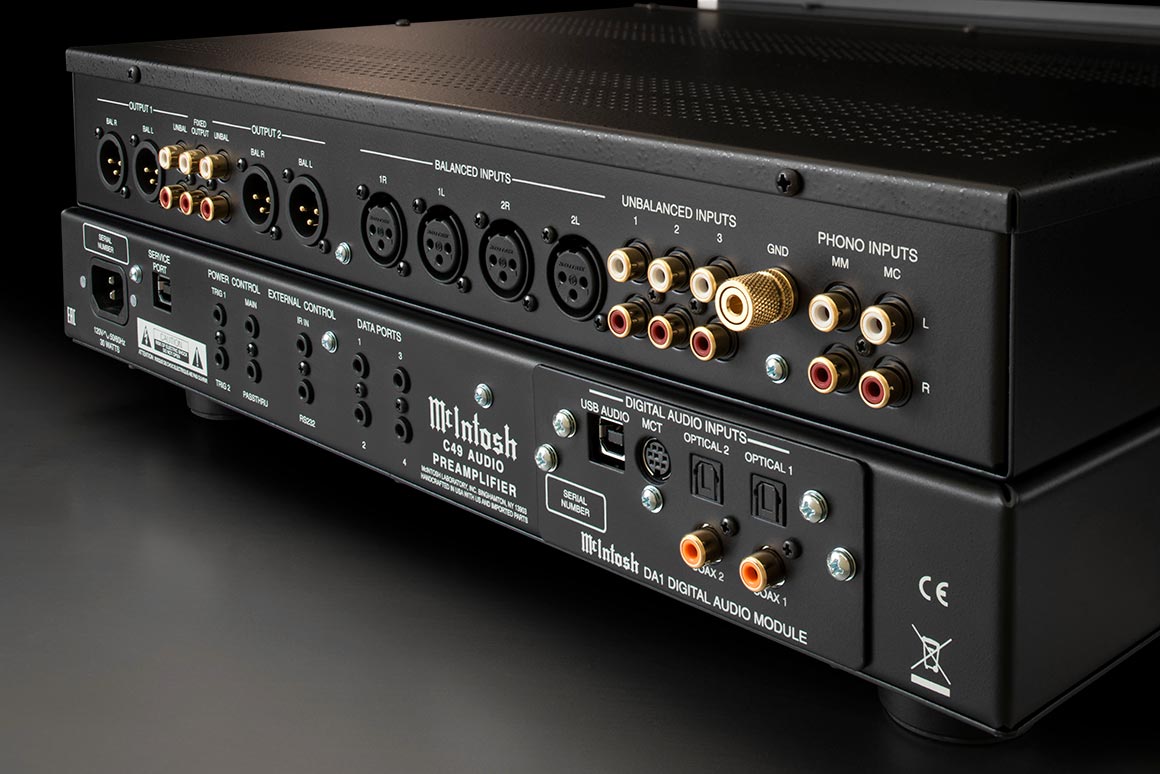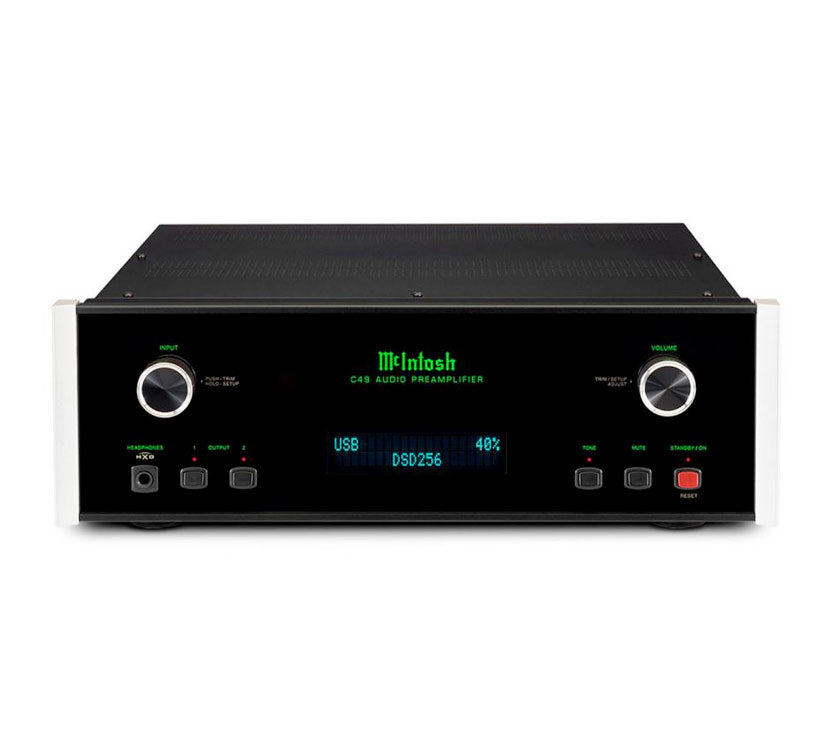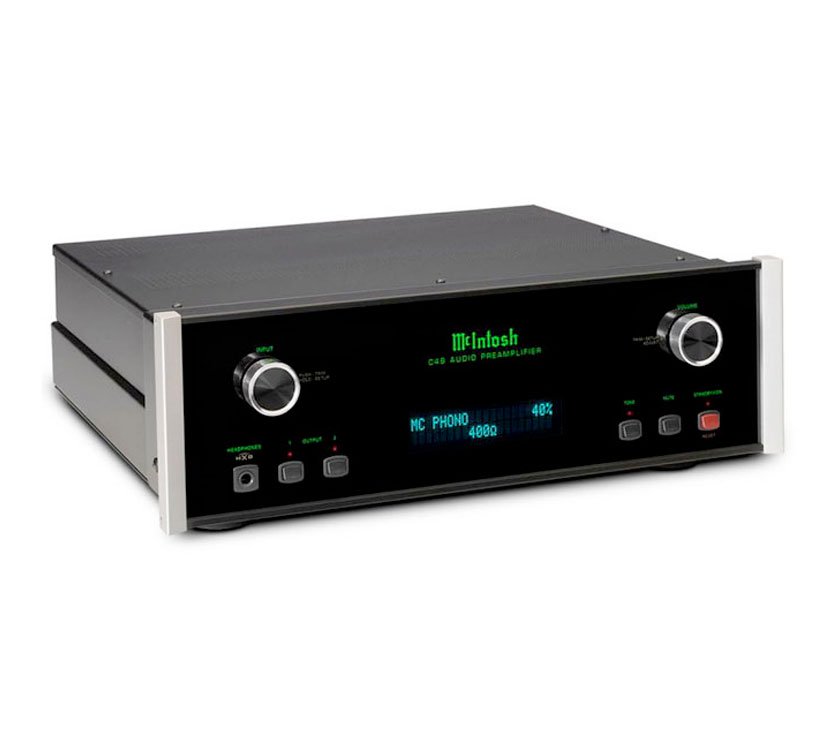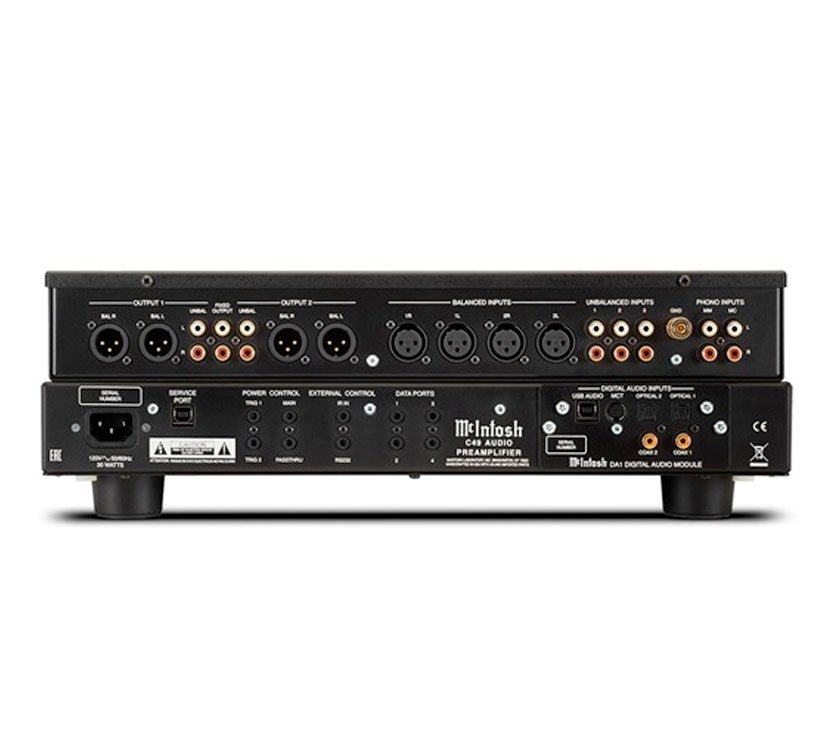McIntosh C49
Couldn't load pickup availability
Free Shipping On All Orders, No Minimums.
We offer free 2-day shipping on most products within the continental US.
Weekdays - Orders placed by 2pm EST ship same day. Orders placed after 2pm EST will ship the following business day.
Weekends - Orders placed on Saturday and Sunday will ship Monday.
Orders requiring motor freight delivery may take more than two business days. Once your order has shipped, you'll receive a shipping confirmation email with a tracking number for easy tracking.
Orders that contain items that are currently backordered, special order, or out of stock will ship complete once all items are in-stock unless otherwise requested.
If you need it faster, you will have the option of choosing a quicker shipping option when you checkout on the website.
At this time, we do not ship internationally and orders to Hawaii and Alaska may incur an additional shipping charge. Please contact us at 888.899.8776 or email support@audioadvice.com to confirm.
Rerouting and Address Changes
We cannot make ANY address changes once an order is placed. If you are unable to accept delivery of your package as ordered, we will need to cancel your order, return the package to sender and have you replace your order through our website.
Keep the Box
We suggest you keep the shipping box or boxes for at least 30 days. It is actually a great idea to keep boxes for audio products for the life of the product. Having the box and all packing will increase the trade-in value should you decide to move up and they are handy to have should you ever need to send the unit in for repair.
How To Receive a Motor Freight Order
The trucking company will contact you to schedule a convenient time to deliver the order. Please note that you must be present for delivery.
Visually inspect the box to make sure you see no signs of damage. If you notice any damage at all, take some pictures with your phone and make a note of them on the delivery receipt the driver will ask you to sign. If it is obvious that the product is damaged, please refuse the order and contact us immediately at 888.899.8776 or email support@audioadvice.com.
Open your box as soon as possible and inspect the product for damage and contact us if you find anything wrong.
uShip In-Home Delivery
Due to current concerns surrounding COVID-19, uShip is able to offer THRESHOLD SERVICE ONLY at this time. To ensure everyone’s safety, uShip is advising carriers to refrain from making room-of-choice deliveries. Threshold service consists of the shipment being brought into the first door of the address or the lobby of an apartment/condo, and does not include set-up, installation, assembly or debris removal.
What to Expect: Most oversized items will be delivered within 2-3 weeks. Your carrier will place your item inside the first door of the address or the lobby of an apartment/condo.
Appointment Scheduling: Your delivery partner will call 24-48 hours prior to delivery to arrange an appointment window.
How to prepare for in-home delivery:
- Determine the clearest path from the street to your home
- Measure entrances and hallways to ensure your item will fit
- Remove any wall hangings or clutter to ensure a clear path and to prevent damages
- Remove old furnishings to allow placement for your new piece
Check your furniture for damages: We rarely expect damaged furniture, but in the instance it does happen, we have you covered. Once your item’s packaging is removed, check for any damages that may have occurred in transit. Take pictures of any damages and notate appropriately on the delivery receipt. Keep possession of the damaged piece and contact us via phone or email and we’ll start the process to repair/replace your new piece of furniture. For uShip customer support, please call 800-698-7447.
At Audio Advice, we pride ourselves on customer satisfaction. We'll bend over backward to make sure you're 100% satisfied and we won't accept anything less. We offer 30-day hassle-free returns and personalized service from real, live people.
If an item doesn't meet your expectations, you may return or exchange it in its original condition and packaging within 30 days for a full refund, minus shipping fees. Items shipped back in like new condition through standard shipping carriers will only incur a flat fee of $15 to return. If the items were initially shipped through free scheduled delivery via motor freight (commonly referred to as LTL), returning them will result in return shipping fees starting at $150. These items include but are not limited to, oversized items such as TVs, certain subwoofers, floorstanding speakers, furniture, and most items weighing over 75 pounds. Return fees will also apply for exchanges. We want to treat your system as if it is our own and want you to be completely satisfied with your purchase.
Please see the instructions below. We only accept returns for any product purchased directly from our website. If merchandise is not returned in its original condition or is missing packaging, manuals, accessories or other parts, or the resale value of the product has been impaired, a partial refund will be given and calculated on a case-by-case basis.
Non-Returnable Items
The following items cannot be returned or cancelled:
- Special/Custom Order Items
- Open Box Products
- Gift Cards
- In-ear headphones cannot be returned once the packaging has been opened due to personal hygiene reasons. Please contact our customer care team if you'd like help choosing.
-
Turntables With a Broken Stylus: All turntables ship out with the stylus intact. If you return a turntable or phono cartridge with a broken or missing stylus you will be subject to a return fee. Please be careful when setting up your turntable and contact us with any questions.
Is It Easy To Return An Item?
Yes, simply give us a call at 888.899.8776 or you can email our support team at support@audioadvice.com. Many times our team of experts can help figure out why the product might not be working like you expected and get things fixed over the phone, so don’t be surprised if we ask a few questions, we love troubleshooting!
If our tech help can not make you happy, we will email over a return shipping label with a Return Number.
Hopefully, you saved all of the original item’s box and packaging inserts. You will want to pack back up your return or exchange in the same way it came out of the original box. Once you have everything packaged correctly, tape the box on the top and bottom to assure it stays together. If Audio Advice shipped the item to you inside a second box, it's a good idea to use that same extra box to help prevent damage on its way back to us. To avoid it accidentally coming back to you, use a magic marker to cross out the old shipping label or just tear it off.
The return shipping label we send you will have our address on it, just make sure you take the box to the right shipper (UPS, FEDEX, or USPS) as per the label.
If you are close to one of our stores, please let us know if it is more convenient for you to return it to us directly. You will still need to get a return number by contacting us and shipping and/or restocking charges may apply.
When Will I See My Refund?
It usually takes around 7-14 days for the refund to show up on the payment method you used. We do inspect all returns for damage and accuracy of the item inside the box before issuing a refund. Some items may be subject to shipping and restocking fees.
Can I Exchange My Purchase For Something Different?
Sometimes those big speakers just don’t fit in the room or you might have bought a small subwoofer and later found out you’d love a bigger one. If you would like to make an exchange within 30 days of receiving your item, just give us a call at 888.899.8776 or email support@audioadvice.com and we will help work out the details. Additional shipping charges and return costs may apply.
How Do I Cancel An Order?
If the item has already shipped out or is a special order item, it is not possible to cancel the order. Please contact us at 888.899.8776 or email support@audioadvice.com to start the return process.
What If I Find Shipping Damage?
We need to know right away about any shipping damage. Please contact us at 888.899.8776 or email support@audioadvice.com within 48 hours of your delivery so we can get the ball rolling on making things right. It’s very helpful to take some pictures and email them to us if possible.
Can I Refuse A Shipment?
You can, but unless the item is damaged, shipping and restocking fees will be deducted from your refund. If your item arrives damaged and you are lucky enough to be there, snap some quick pics and refuse the order. Then contact us so we can get a replacement on the way.
What Happens If My Order Is Defective?
This is actually pretty rare, most consumer electronics work fine out of the box 99.9% of the time. We’d like for you to contact us first by calling 888.899.8776 or email support@audioadvice.com so we can help get to the bottom of things. If your item is indeed defective during the first 30 days, we can usually exchange it for a new, replacement unit.
What About Service After 30 Days?
Audio Advice has a great relationship with all of our brands and can help you with warranty service by the brand after our 30-day guarantee period. Even after the warranty expires, we can arrange for service by the brand on products purchased from Audio Advice. Just call 888.899.8776 or email support@audioadvice.com.
How Do You Determine A Restocking Fee?
You may not believe it, but sometimes we receive items back that were put in the box with zero packaging and are completely destroyed or are missing many of the pieces that came with the item. We also track serial numbers and will get back different serial numbers. We’ve even seen different items than what we shipped out be returned. However, it’s very important to package your return properly so that nothing goes missing or gets damaged in shipping, which will result in a restocking fee or even no refund at all. If a product is opened and the market value of the product is reduced, then a restocking fee may be applied to the cost of restocking and the reduced market value of the product. The bottom line is if you treat us fairly, we will do the same.
Audio Advice strives to provide industry-leading support and service while also maintaining the lowest prices available on products for our customers. We work hard with our vendors to bring our customers the best products at each price point. As a part of that process, we work with our vendors to provide the lowest pricing in our stores and on our website.
Our prices should always be the same as any other authorized dealer, including big-box retailers and major online retailers.
If you believe that you have found a lower advertised price from a legitimate authorized seller, call us and let us know so we can make sure we can correct any inadvertent error on our side. As a matter of policy, we update our prices automatically if a vendor changes its authorized pricing policies, so we generally have the best prices all the time. Increasingly, there are knock-off copies of products online, usually sold by non-authorized dealers.
Please be sure that the item meets the following conditions:
- The item is brand new, in stock, and available for purchase
- The item has the identical model number, color, etc as the item on our site.
- The seller is an authorized dealer
As always, our goal is to provide a terrific customer experience, including industry low prices. We appreciate your support.
Overview
Be prepared for future digital music technologies with the C49 Preamplifier. The C49 features McIntosh's DA1 Digital Audio Module, which can be replaced by new modules as new digital audio technologies are developed. This will allow you to keep your C49 up to date with digital music formats and viable well into the future. McIntosh wanted to give music lovers a new preamp that enabled them to connect to just about any type of music source available today. Also, while you can just make a couple of connections and be making music with the C49 quickly, there are a ton of fun features under the hood that allows you to customize the Mcintosh C49 to your system. And it goes without saying, just like every McIntosh product, the C49 is built to last for decades!
The High Notes

Classic Warm McIntosh Sound

Upgradeable Digital Board

Incredible Flexibility
Company & Product Overview
The year was 1946 when Frank McIntosh hired Gordon Gow to work on a special project for him. Frank McIntosh, at the time, was a consultant to the TV broadcast industry. Frank saw a demand for a high powered, low distortion amplifier. In 1949, the McIntosh brand was born out of this partnership. McIntosh Labs moved to Binghamton, NY in 1951 and have been at their current location in Binghamton since 1956.
We recently visited the McIntosh facility and it really is interesting to see how the building has grown over the past 60+ years. A quick Google Maps search of 2 Chambers St Binghamton, NY will show you all the additions. Another interesting fact about McIntosh is the average employee tenure is over 20 years!
McIntosh has become world-renowned for designing and manufacturing almost every single thing in-house. They also pride themselves on being able to repair just about any McIntosh product ever made. This philosophy coupled with their great sound has led to McIntosh products holding their value better than any other audio brand. When we toured the factory, we were amazed at the level of in house expertise they have. Not only do they make and assemble all of the audio portions of the gear at the factory, but they also bend and paint their own metal, cut and etch their own glass, and even wind and pot their own transformers. It is truly a remarkable tour if you are into audio at all!
With all of the expertise McIntosh puts into their products, they are not the type of brand who comes out with new models every year just to have a new number designation. They only make a change when enough technology has come out that warrants a new model, which in some cases can be 10 years or more. The subject of today’s review is such a revision to what is probably one of the most popular McIntosh products, their entry-level, solid-state, full-function preamplifier, the McIntosh C49. The new McIntosh C49 preamp is just starting to make its way out into the audio world and is loaded with far more features and technology than you might think from having a quick look at its beautiful front faceplate.
Design & Build Quality
When you spend time at the McIntosh factory and get to know the people there, a philosophy starts to emerge that becomes clearer and clearer with each person you meet. It actually has more than one facet, but they all come together to help you understand why McIntosh owners are so happy with their purchases.
- McIntosh wants to create products that you can pass down to the next generation.
This has several aspects on its own. For an audio product to last this long, it needs to be built to extremely high standards. The company has to have a dedication to supporting it for decades, which is a rare find in today’s disposable marketplace. Finally, the product has to sound so good that even after 50 years it can still hold its own against the latest technology.
- McIntosh wants their products to be extremely easy to use, yet offer up all kinds of ways to tune the product to your personal tastes should you desire.
This is not an easy feat to pull off, but we have to say, McIntosh has this perfected. More on this and how it relates to the McIntosh C49 in the next section.
- McIntosh products inspire a great sense of pride of ownership through their beauty and connection to the music.
The beautiful glass faceplates, some of which have the classic McIntosh blue meters, are almost like a piece of art in your home. Everyone on the McIntosh team also has a passion for music. From the early days when they powered Woodstock to the Grateful Dead’s “Wall of Sound”, McIntosh gear has a history of connecting you to the music with a sense of raw power and emotion that has to be experienced.
The new McIntosh C49 solid-state preamp embodies all of these principals in a complete control center for today’s music lovers. McIntosh wanted to give music lovers a new preamp that enabled them to connect to just about any type of music source available today. Also, while you can just make a couple of connections and be making music with the C49 quickly, there are a ton of fun features under the hood that allows you to customize the Mcintosh C49 to your system. And it goes without saying, just like every McIntosh product, the C49 is built to last for decades!

Features & Technology
When we were touring the production lines we noticed some pieces that looked like they were only half of a product. It turns out, these were the two parts that make up the C49 preamp. The McIntosh C49 has an abundance of both analog and digital inputs. To keep the analog signal path as pure as possible, the preamp is two completely separate units tied together.
The top half houses the analog section which gives you two sets of outputs with both balanced and single-ended RCA output. There is also a third fixed RCA audio out. You’ll get two pairs of balanced audio inputs, 3 RCA audio inputs, and both a moving coil and moving magnet set of phono inputs. The other half of the preamp houses the power supply and the digital section.
The DA1 digital audio module is also modular so if there is a huge technology change, it can be updated over time. Although for right now, it is totally at what is state of the art with its 8-channel 32 Bit DAC used in a Quad Balanced mode. It supports DSD256 and DXD384kHz for high-resolution audio. The DA1 module gives you a USB digital input, two Toslink inputs, and two coax digital inputs. You also get a special MCT input designed to work with McIntosh SACD transports. This adds up to an input count of 13, pretty impressive leaving you plenty of room for all kinds of source components. The back panel of the digital/power half also houses 10 mini jacks which can be used for all kinds of cool control functions with other McIntosh gear.
One could take the McIntosh C49 out of the box, connect up a CD transport to the digital input and a turntable to the correct phono input and quickly be making great sound. That is part of the McIntosh philosophy, but if you want to dive deeper to tweak things to your liking, you’ll find a world of cool features. But first, let’s have a look at the beautiful glass front panel and its functions.
It only takes about 2 seconds for anyone to figure out how to operate the McIntosh C49, it is so well laid out. The left side has a round input selection knob. In the center is a visual display to show you what you have selected. On the far right is the volume knob. Underneath the input knob, you’ll find a full-sized headphone jack. McIntosh uses an internal dedicated high power headphone amp using what they call their HighDrive tech that can power just about any headphone on the market. Next to the headphone jack are two switches that turn on or off each of the two, independent preamp outputs. The right side has an easy-to-find power on/off switch, a switch to engage or disengage the tone controls, and a mute button. Every switch has a red light that indicates if the switch is in the on position. McIntosh is also very clever in the way the labeling for all of the controls is on the rear side of the glass. This means it will never wear off, preserving the great resale value McIntosh gear is known for.
By pressing inward on the input button, you’ll get into the setup menu where you will be able to fine-tune the McIntosh C49 to your system. There are several features we discovered that we really love:
First, is the extreme flexibility of the phono section. The moving magnet section lets you adjust from 50 to 800pF in 50 pF steps, while the moving coil stage allows you to load the cartridge at 25, 50, 100, 200, 400 or 1,000 ohms. Other phono preamps have this feature, but the neat part here is you can do these on the fly with the handheld remote, enabling you to quickly hear the change!
The Mcintosh C49 also has a home theater bypass mode. Many high performance 2 channel products have added this feature recently. It lets you connect all of your dedicated audio-only gear to your great McIntosh C49 preamp, then connect up your surround sound processor or receiver’s front channel outputs to the C49. This enables you to combine a dedicated two-channel system and a home theater setup with zero compromises to the sound of your two-channel gear.
McIntosh will let the adjuster or purist in you have your cake and eat it too, with their tone and balance control circuitry. You’ll be able to adjust bass, treble, and balance or if you wish, completely disable those circuits for a pure signal path. But let’s face it, some of those older classic recordings can sometimes use a little help, so we are happy to see the built-in tone controls.
For handling all of those 13 inputs, McIntosh gives you the ability to name each one to your personal tastes and also trim the input volume up or down on everyone. This means when you switch from source to source, they can all be at the same volume level.
If you dive deep into the headphone amp setup, you’ll find a great feature set. Most preamps will totally mute the audio output on the preamp out jacks when you plug in a set of headphones. The McIntosh C49 defaults to this setting as well but gives you two more options. You can have it just mute the main outputs, leaving output 2 and 3 active or mute no outputs.
McIntosh products all have a goal of minimal noise and distortion which is exemplified in the split chassis of the C49. Another way to reduce noise is to have as little internal wiring as possible. If you were to pull out the boards for the C49, you would notice very little wiring at all. The signal switching all takes place right at the connectors through a special control circuit that talks to the front panel. The C49 also uses McIntosh’s best volume control design. This uses optoelectronic circuitry that gives you the ability to fine-tune the volume in minute steps. No signal passes through the volume knob assuring years of noise-free service. But, unlike some preamps where you have to keep spinning the volume knob for several rotations to get things loud, the C49 senses when you are moving the knob faster, ramping the volume up quickly. Once you have it close to where you want it, slow turns fine-tune the volume in tiny steps, pretty cool!
One the digital side of tech, the McIntosh Quad Balanced DAC design cancels out any noise or distortion present in the digital conversion process. The result is a digital section that gives you an extremely smooth sound with never a trace of harshness.
The final part of the secret sauce inside the McIntosh C49 that makes it sound so sweet is simply the McIntosh heritage of component evaluation and testing. When you make products that last for decades, your engineers start to get a really good sense of what types and brands of all the tiny resistors, diodes, capacitors and more inside a preamp not only sound great now but hold their great sound and specs into the future. With the C49, you are getting 70 years of audio design experience assuring you of outstanding sound decades down the road.

Performance
McIntosh sent us a C49 before our full order of demo gear arrived, so we wound up testing it somewhat stand-alone outside of a full McIntosh stack. This is probably not the typical way it would be used as most McIntosh owners couple a McIntosh preamp with one or more of their power amps, but since the McIntosh C49 is brand new, we wanted to get a review out quickly.
We paired it up with a Mark Levinson 534 power amp and one of our favorite speakers, the Revel Salon 2 with everything wired up using Transparent Audio cables.
Several of our friends in the industry had told us to expect to be surprised by the sound of the new McIntosh components, in a good way! When we visited the factory, the sound we experienced was very impressive, but there is just something about putting a piece of gear into a system you are familiar with that tells the true tale.
The preamp we pulled out to test the McIntosh was a $20,000 digital only preamp so we wondered how the $5000 C49 would hold up. The answer came pretty quickly and got clearer after a few tracks.
Some people have loved the McIntosh sound for its super warm character, but it has been criticized as not being as open and effortless as other state of the art contenders. A few notes into the first track and we could tell there was absolutely zero lack of openness, as a matter of fact, the effortless sound was making us smile. The first cut we tried was from Shelby Lynne’s "Just a Little Lovin". There are some percussive sounds that are recorded with a lot of decay added and we could hear every bit of this as the sound slowly faded away in a super effortless fashion. The dynamics of the percussion and deep bass were also very impressive to our ears.
We moved on to "Man in the Long Black Coat" from Bob Dylan. At the beginning of the track, there are guitars in the left and right channels and a great system will place these guitars a little bit outside the main speakers. We heard this exact effect with the McIntosh C49, plus the acoustic energy coming off the guitars had zero sense of strain. A few more seconds into this track brings on some rich harmonica sounds. Here, the warmth and effortlessness this preamp lets through just drew you into the music.
Our last cut was "Billy Jean" from Between the Bars. A great system will let you really hear into the harmonics of the guitars. Checkmark again. The McIntosh C49 was doing a great job here as well and when the haunting vocals came in, we just sat and listened through the whole song.
We did switch back to our reference preamp and in many aspects, it was clearly better, but in the end, we were super impressed with the sound quality of the C49 for what it costs in today’s world of electronics that cost more than a nice car.
Overall Recommendation
A great audio preamp can be the heart of a music system for decades. Many people wind up replacing what they thought was a good choice due to it lacking a feature or type of input that comes out in the future. With the modular digital section and the plethora of analog with MC and MM phono, we see the McIntosh C49 being in your system for decades. When you look at all you get for $5000 compared to the competition out there, it seems like a great value to us. Plus it's just beautiful to look at and fun to operate!
Details & Specs
The C49 comes with a multitude of inputs. For analog, it has 2 balanced and 3 unbalanced, along with 2 phono inputs (comprised of 1 Moving Coil and 1 Moving Magnet) for connecting turntables. On the digital side, it has 6 inputs housed in the DA1 module. The inputs are 2 coaxial, 2 optical, 1 USB and 1 proprietary MCT (for use with our MCT series of SACD/CD Transports). The DA1 is powered by an 8-channel, 32-bit Digital-to-Analog Converter (DAC) that is used in Quad Balanced mode; it supports up to DSD256 and DXD 384kHz for playback of high-resolution audio. In total, the C49 has 13 inputs, and each can be given user-friendly names to simplify system setup and control.
For connecting to your amplifier and the rest of your home audio system, the C49 has 2 balanced variable outputs, 2 unbalanced variable outputs, and 1 unbalanced fixed output. The outputs are designed for easy use when bi-amping your speakers so that neither your highs or lows are inadvertently turned off. Your audio sources can be fine-tuned via the bass and treble tone controls.
The C49 can be seamlessly integrated into your home theater system via Home Theater Pass-Through. Power Control ports allow for the easy turn on/turn off of other connected McIntosh components, while the Data Ports can send remote control commands to connected source components. Our High Drive headphone amplifier with Headphone Crossfeed Director (HXD) is also included. The C49 comes complete with classic McIntosh design staples such as a black glass front panel, knobs, an illuminated logo, and aluminum end caps. Pair it with a variety of amplifiers, turntables, CD players, tuners, speakers, power controllers, and room correction devices to make a complete home audio system. Contact your local dealer to learn more.
- Frequency Response: +0, -0.5dB from 20Hz to 20kHz / +0, -3.0dB from 15Hz to 100kHz
- Total Harmonic Distortion: 0.005% maximum from 20Hz to 20kHz
- Signal to Noise Ratio (High Level): 100dB
- Maximum Voltage Output: Balanced: 16 Vrms / Unbalanced: 8 Vrms
- Analog Inputs: 2 Balanced / 3 Unbalanced / 1 Moving Coil / 1 Moving Magnet
- Digital Inputs: 2 Coax / 2 Optical / 1 USB / 1 MCT (used with McIntosh MCT series SACD/CD Transports)
- Overall Dimensions (W x H x D): 17-1/2” (44.45cm) x 6” (15.2cm) including feet x 18” (45.72cm) including the front panel, knobs and cables
- Weight: 23 lbs (10.4kg) net, 37.5 lbs (17kg) in shipping carton































 Home Theater
Home Theater Speakers
Speakers Tower Speakers
Tower Speakers
 Bookshelf Speakers
Bookshelf Speakers
 Center Channel Speakers
Center Channel Speakers
 Wall & Ceiling Speakers
Wall & Ceiling Speakers
 Surround Speakers
Surround Speakers
 Dolby Atmos Speakers
Dolby Atmos Speakers
 Subwoofers
Subwoofers
 Soundbars
Soundbars
 Speaker Stands & Mounts
Speaker Stands & Mounts
 Components
Components Home Theater Receivers
Home Theater Receivers
 Surround Sound Processors
Surround Sound Processors
 Power Amps
Power Amps
 Movie Sources
Movie Sources
 TVs & Projectors
TVs & Projectors Televisions
Televisions
 Projectors
Projectors
 Projector Screens
Projector Screens
 TV & Projector Mounts
TV & Projector Mounts
 Seating & Furniture
Seating & Furniture Home Theater Seating
Home Theater Seating
 Media Cabinets
Media Cabinets
 A/V Racks & Shelves
A/V Racks & Shelves
 Accessories
Accessories
 Acoustic Treatments
Acoustic Treatments Absorption Panels
Absorption Panels
 Bass Trap Panels
Bass Trap Panels
 Diffusion Panels
Diffusion Panels
 Acoustic Treatment Packages
Acoustic Treatment Packages
 Cables & Accessories
Cables & Accessories HDMI Cables
HDMI Cables
 Analog Cables
Analog Cables
 Digital Cables
Digital Cables
 USB Cables
USB Cables
 Speaker Cables
Speaker Cables
 Subwoofer Cables
Subwoofer Cables
 Power Management
Power Management
 Featured & Deals
Featured & Deals Best Sellers
Best Sellers
 Sale
Sale
 Home Audio
Home Audio Outdoor Speakers
Outdoor Speakers
 Portable & Bluetooth
Portable & Bluetooth
 Wireless Speaker Systems
Wireless Speaker Systems
 Computer Speakers
Computer Speakers
 Powered Speakers
Powered Speakers
 Integrated Amplifiers
Integrated Amplifiers
 Power Amplifiers
Power Amplifiers
 Stereo Preamplifiers
Stereo Preamplifiers
 Stereo Receivers
Stereo Receivers
 Streaming Media Players
Streaming Media Players
 Digital-to-Analog Converters
Digital-to-Analog Converters
 CD Players
CD Players
 Outdoor Entertainment
Outdoor Entertainment Outdoor Subwoofers
Outdoor Subwoofers
 Turntables
Turntables Manual
Manual
 Automatic
Automatic
 Phono Cartridges
Phono Cartridges Moving Coil
Moving Coil
 Moving Magnet
Moving Magnet
 Moving Iron
Moving Iron
 Mono
Mono
 Phono Preamps
Phono Preamps MC Compatible
MC Compatible
 MM Compatible
MM Compatible
 Record Cleaning & Care
Record Cleaning & Care Stylus Care
Stylus Care
 Cleaning Machines
Cleaning Machines
 Record Cleaning Fluid
Record Cleaning Fluid
 Record Sleeves
Record Sleeves
 Isolation Systems
Isolation Systems Turntable Setup Tools
Turntable Setup Tools
 Turntable Cables
Turntable Cables
 Record Weights
Record Weights
 Turntable Mats
Turntable Mats
 Headphones
Headphones In-Ear Headphones
In-Ear Headphones
 On-Ear Headphones
On-Ear Headphones
 Over-Ear Headphones
Over-Ear Headphones
 Wireless Headphones
Wireless Headphones
 Gaming Headsets
Gaming Headsets
 Headphone Amps & DACs
Headphone Amps & DACs Digital Audio Players
Digital Audio Players
 Smart Home
Smart Home Deals
Deals Limited Time Deals
Limited Time Deals Deals by Category
Deals by Category